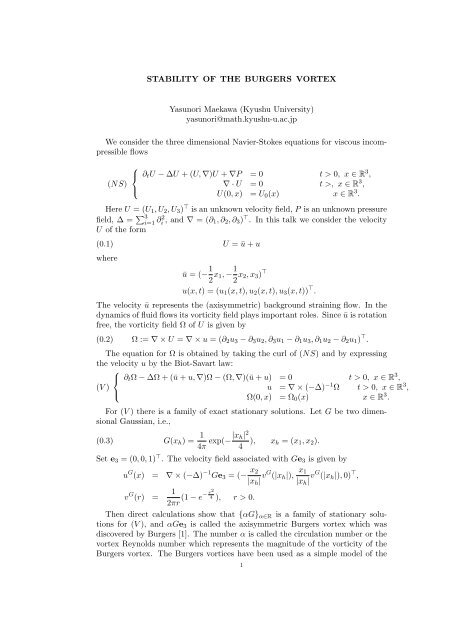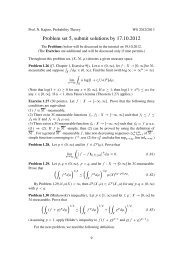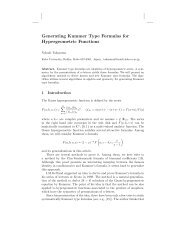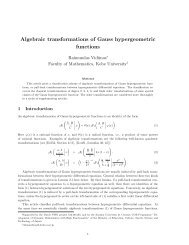STABILITY OF THE BURGERS VORTEX Yasunori ... - Kobe University
STABILITY OF THE BURGERS VORTEX Yasunori ... - Kobe University
STABILITY OF THE BURGERS VORTEX Yasunori ... - Kobe University
You also want an ePaper? Increase the reach of your titles
YUMPU automatically turns print PDFs into web optimized ePapers that Google loves.
<strong>STABILITY</strong> <strong>OF</strong> <strong>THE</strong> <strong>BURGERS</strong> <strong>VORTEX</strong><br />
<strong>Yasunori</strong> Maekawa (Kyushu <strong>University</strong>)<br />
yasunori@math.kyushu-u.ac.jp<br />
We consider the three dimensional Navier-Stokes equations for viscous incompressible<br />
flows<br />
(NS)<br />
⎧<br />
⎨<br />
⎩<br />
∂ t U − ∆U + (U, ∇)U + ∇P = 0 t > 0, x ∈ R 3 ,<br />
∇ · U = 0 t >, x ∈ R 3 ,<br />
U(0, x) = U 0 (x) x ∈ R 3 .<br />
Here U = (U 1 , U 2 , U 3 ) ⊤ is an unknown velocity field, P is an unknown pressure<br />
field, ∆ = ∑ 3<br />
i=1 ∂2 i , and ∇ = (∂ 1, ∂ 2 , ∂ 3 ) ⊤ . In this talk we consider the velocity<br />
U of the form<br />
(0.1) U = ū + u<br />
where<br />
ū = (− 1 2 x 1, − 1 2 x 2, x 3 ) ⊤<br />
u(x, t) = (u 1 (x, t), u 2 (x, t), u 3 (x, t)) ⊤ .<br />
The velocity ū represents the (axisymmetric) background straining flow. In the<br />
dynamics of fluid flows its vorticity field plays important roles. Since ū is rotation<br />
free, the vorticity field Ω of U is given by<br />
(0.2) Ω := ∇ × U = ∇ × u = (∂ 2 u 3 − ∂ 3 u 2 , ∂ 3 u 1 − ∂ 1 u 3 , ∂ 1 u 2 − ∂ 2 u 1 ) ⊤ .<br />
The equation for Ω is obtained by taking the curl of (NS) and by expressing<br />
the velocity u by the Biot-Savart law:<br />
⎧<br />
⎨ ∂ t Ω − ∆Ω + (ū + u, ∇)Ω − (Ω, ∇)(ū + u) = 0 t > 0, x ∈ R 3 ,<br />
(V )<br />
u = ∇ × (−∆) −1 Ω t > 0, x ∈ R 3 ,<br />
⎩<br />
Ω(0, x) = Ω 0 (x) x ∈ R 3 .<br />
For (V ) there is a family of exact stationary solutions. Let G be two dimensional<br />
Gaussian, i.e.,<br />
(0.3) G(x h ) = 1<br />
4π exp(−|x h| 2<br />
4 ), x h = (x 1 , x 2 ).<br />
Set e 3 = (0, 0, 1) ⊤ . The velocity field associated with Ge 3 is given by<br />
u G (x) = ∇ × (−∆) −1 Ge 3 = (− x 2 x 1<br />
|x h | vG (|x h |),<br />
|x h | vG (|x h |), 0) ⊤ ,<br />
v G 1<br />
(r) =<br />
2πr (1 − e− r2 4 ), r > 0.<br />
Then direct calculations show that {αG} α∈R is a family of stationary solutions<br />
for (V ), and αGe 3 is called the axisymmetric Burgers vortex which was<br />
discovered by Burgers [1]. The number α is called the circulation number or the<br />
vortex Reynolds number which represents the magnitude of the vorticity of the<br />
Burgers vortex. The Burgers vortices have been used as a simple model of the<br />
1
2 <strong>THE</strong> <strong>BURGERS</strong> <strong>VORTEX</strong><br />
vortex tubes observed in numerical simulations of the three dimensional turbulent<br />
flows, and their stability has been investigated by many researchers. As for<br />
the mathematical researches, the stability with respect to purely two dimensional<br />
perturbation flows (in this case ω = (0, 0, ω 3 (x 1 , x 2 , t)) ⊤ in the above equation)<br />
was firstly studied by Giga-Kambe [5] and their results were extended by Carpio<br />
[2], Giga-Giga [6], Gallay-Wayne [3], and [7]. Especially, in [3] it is proved that the<br />
Burgers vortex is globally stable with respect to two dimensional perturbations<br />
for any circulation numbers. In this talk we discuss the three dimensional stability<br />
of the Burgers vortex. The most important step is to analyze the linearized<br />
equation around αGe 3 as follows.<br />
(0.4) ∂ t ω − (L − αT )ω = 0 t > 0, x ∈ R 3 .<br />
Here ω = (ω 1 , ω 2 , ω 3 ) ⊤ , v = ∇ × (−∆) −1 ω, and<br />
(0.5)<br />
(0.6)<br />
Lω = ∆ω − (Mx, ∇)ω + Mω, Mx = (− 1 2 x h, x 3 ) ⊤ ,<br />
T ω = (u G , ∇)ω − (ω, ∇)u G + (v, ∇)Ge 3 − G∂ 3 v.<br />
Let us introduce the function spaces.<br />
L 2 G(R 2 ) = {f ∈ L 2 (R 2 ) | G − 1 2 f ∈ L 2 (R 2 )},<br />
∫<br />
L 2 G,0(R 2 ) = {f ∈ L 2 G(R 2 ) | f(x h )dx h = 0},<br />
R 2<br />
X 2 = L 2 (R; L 2 G(R 2 )), X 2,0 = L 2 (R; L 2 G,0(R 2 )), X 2 = X 2 × X 2 × X 2,0 .<br />
Then we have<br />
Theorem 1. Let α ∈ R. Then for any ω 0 ∈ X 2 with ∇ · ω 0 = 0, there is a unique<br />
solution ω(t) ∈ C([0, ∞); X 2 ) to (0.4) satisfying the estimate<br />
(0.7)<br />
||ω(t)|| X2 ≤ C||ω 0 || X2 , t > 0.<br />
Here the constant C depends only on |α|.<br />
The more detailed estimates will be shown in the talk. From these results we<br />
can prove the existence of time-global solutions to the full vorticity equations (V )<br />
near the Burgers vortices. Especially, these solutions remain large for all time if<br />
the circulation number is large.<br />
References<br />
[1] Burgers, J. M., A mathematical model illustrating the theory of turbulence. Adv. Appl.<br />
Mech., 1948, 171-199.<br />
[2] Carpio, A., Asymptotic behavior for the vorticity equations in dimensions two and three.<br />
Comm. P. D. E., 19, 1994, 827-872.<br />
[3] Gallay, Th. and Wayne, C. E., Global Stability of vortex solutions of the two dimensional<br />
Navier-Stokes equation. Comm. Math. Phys., 255(1), 2005, 97-129.<br />
[4] Gallay, Th. and Wayne, C. E., Three-dimensional stability of Burgers vortices : the low<br />
Reynolds number case. Phys. D., 213, 2006, no. 2, 164-180.<br />
[5] Giga, Y. and Kambe, T., Large time behavior of the vorticity of two dimensional viscous<br />
flow and its application to vortex formation. Comm. Math. Phys., 117, 1988, 549-568.<br />
[6] Giga, Y. and Giga, M.-H., Nonlinear Partial Differential Equation, Self-similar solutions<br />
and asymptotic behavior; Kyoritsu: 1999 (in Japanese), English version to be published by<br />
Birkhäuser.<br />
[7] Maekawa, Y., Spectral properties of the linearization at the Burgers vortex in the high<br />
rotation limit. to appear in J. Math. Fluid Mech.






